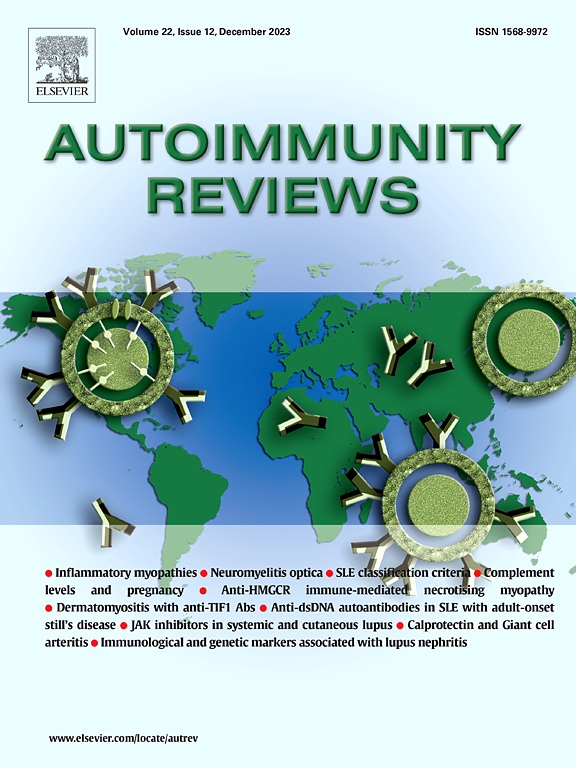The entrenchment of NLRP3 inflammasomes in autoimmune disease-related inflammation
IF 8.3
1区 医学
Q1 IMMUNOLOGY
引用次数: 0
Abstract
Autoinflammation and autoimmunity are almost “opposite” phenomena characterized by chronic activation of the immune system, ‘innate’ in the first and ‘adaptive’ in the second, leading to inflammation of several tissues with specific protean effectors of tissue damage. The mechanism of involvement of multiprotein complexes called ‘inflammasomes’ within autoimmune pictures, differently from autoinflammatory conditions, is yet undeciphered. In this review we provide a comprehensive overview on NLRP3 inflammasome contribution into the pathogenesis of some autoimmune diseases. In response to autoantibodies against nucleic acids or tissue-specific antigens the NLRP3 inflammasome is activated within dendritic cells and macrophages of patients with systemic lupus erythematosus. Crucial is NLRP3 inflammasome to amplify tissue inflammation with interleukin-1 overexpression and matrix metalloproteinase production at the joint level in rheumatoid arthritis. A deregulated NLRP3 inflammasome activation occurs in the serous acini of salivary and lacrimal glands prone to Sjogren's syndrome, but also in the inflammatory process involving endothelial cells, leucocyte recruitment, and platelet plugging of vasculitides. Furthermore, organ-specific autoimmune diseases such as thyroiditis and hepatitis may display hyperactive NLRP3 inflammasomes at the level of resident immune cells within thyroid or liver, respectively. Therefore, it is not unexpected that preclinical studies have shown how specific inflammasome inhibitors may significantly overthrow the severity of different autoimmune diseases and slow down their trend towards an ominous progression. Specific markers of inflammasome activation could also reveal subclinical inflammatory components escaping conventional diagnostic approaches or improve monitoring of autoimmune diseases and personalizing their treatment.
自身免疫性疾病相关炎症中NLRP3炎性小体的强化
自身炎症和自身免疫几乎是“相反”的现象,其特征是免疫系统的慢性激活,第一种是“先天”的,第二种是“适应性”的,导致具有组织损伤特异性蛋白效应的几种组织的炎症。与自身炎症不同,被称为“炎性体”的多蛋白复合物参与自身免疫图像的机制尚未破译。在这篇综述中,我们就NLRP3炎性体在一些自身免疫性疾病的发病机制中的作用进行了全面的综述。在系统性红斑狼疮患者的树突状细胞和巨噬细胞中,NLRP3炎性体在对核酸或组织特异性抗原的自身抗体的反应中被激活。在类风湿关节炎的关节水平上,NLRP3炎性体通过白细胞介素-1过表达和基质金属蛋白酶的产生来放大组织炎症,这是至关重要的。NLRP3炎性小体激活失调发生在易发生干燥综合征的唾液腺和泪腺的浆液腺泡中,但也发生在涉及内皮细胞、白细胞募集和血管血管血小板堵塞的炎症过程中。此外,器官特异性自身免疫性疾病,如甲状腺炎和肝炎,可能分别在甲状腺或肝脏内的常驻免疫细胞水平上显示NLRP3炎症小体过度活跃。因此,临床前研究表明特异性炎性小体抑制剂可以显著降低不同自身免疫性疾病的严重程度,并减缓其不祥进展的趋势,这并不令人意外。炎性小体激活的特定标记也可以揭示逃避常规诊断方法的亚临床炎症成分,或改善自身免疫性疾病的监测和个性化治疗。
本文章由计算机程序翻译,如有差异,请以英文原文为准。
求助全文
约1分钟内获得全文
求助全文
来源期刊

Autoimmunity reviews
医学-免疫学
CiteScore
24.70
自引率
4.40%
发文量
164
审稿时长
21 days
期刊介绍:
Autoimmunity Reviews is a publication that features up-to-date, structured reviews on various topics in the field of autoimmunity. These reviews are written by renowned experts and include demonstrative illustrations and tables. Each article will have a clear "take-home" message for readers.
The selection of articles is primarily done by the Editors-in-Chief, based on recommendations from the international Editorial Board. The topics covered in the articles span all areas of autoimmunology, aiming to bridge the gap between basic and clinical sciences.
In terms of content, the contributions in basic sciences delve into the pathophysiology and mechanisms of autoimmune disorders, as well as genomics and proteomics. On the other hand, clinical contributions focus on diseases related to autoimmunity, novel therapies, and clinical associations.
Autoimmunity Reviews is internationally recognized, and its articles are indexed and abstracted in prestigious databases such as PubMed/Medline, Science Citation Index Expanded, Biosciences Information Services, and Chemical Abstracts.
 求助内容:
求助内容: 应助结果提醒方式:
应助结果提醒方式:


